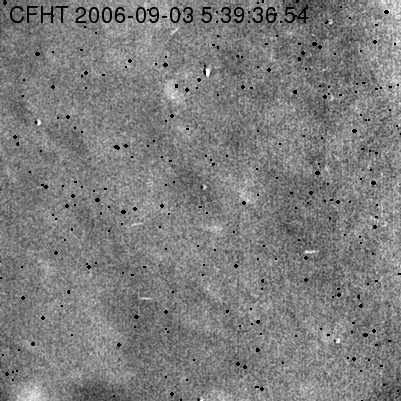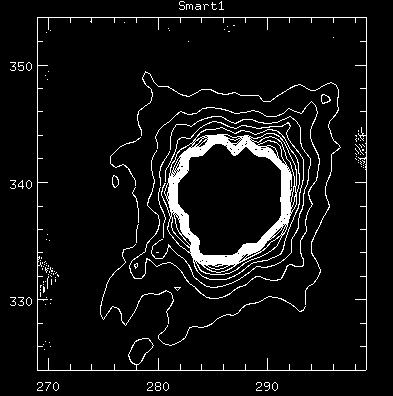SMART-1: Crash into the Moon Part 2
SMART-1 impact flash seen by CFHT telescope

Credit line : Canada-France-Hawaii Telescope- CFHT, 2006.
Above an animation showing a sequence of 20 images covering the impact which is seen only on one image.
This impressive sequence of SMART-1 impact images was captured by the 3.6-meter optical/infrared Canada-France-Hawaii Telescope (CFHT), Hawaii, 3 September 2006.
The CFHT observed the projected impact area between 07:00 - 08:44 CEST (05:00 06:44 UT). The impact flash lasted only about 1 millisecond. It may have been caused by the thermal emission from the impact itself or by the release of spacecraft volatiles, such as the small amount of hydrazine fuel remaining on board.

Credit line: Canada-France-Hawaii Telescope- CFHT, 2006.
The observations were made with the WIRCam wide-field infrared, 10s exposure time - H2 narrow-band filter at 2122 nanometers with a 32 nanometers bandwidth. Image size: 2' x 2' (or ~200km x 200km).
Credit line: Canada-France-Hawaii Telescope- CFHT, 2006.
This contour map of the flash, so bright that it is saturated, shows that the North (top) and South (bottom) of the flash are not identical.
There is a clear elongation on the South side in the direction of the motion.
The elongations at 45 degrees are due to the diffraction pattern from the secondary mirror supports (the spider). The units on the axes of the graph are WIRCam pixels: 0.3" or ~0.5km.
Analysis of images obtained at the Canada-France-Hawaii Telescope - CFHT (3.6 meters) by Christian Veillet have revealed a plume of debris thrown up when SMART-1 impacted the lunar surface.
Credits : Canada-France-Hawaii Telescope - CFHT / 2006.
Another animation where the dust cloud is seen...
Below, a mosaic of 15 exposures starting with the one at the time of the flash.

Credits: Canada-France-Hawaii Telescope - CFHT / 2006.
Flash Captured by Amateur Astronomer
The flash below was captured by amateur astronomer Peter Lipscomb in Saint Fe, New Mexico (USA).
Credits: Peter Lipscomb, Saint Fe, New Mexico (USA)
In the images, the terminator is to the right of the field of view. There is some gradiant shown in the frame which appears to darken the more one looks to the left. Lunar North is down.
Complete Animation in: http://cosmonut.org/Smart-1.gif
Peter used a Meade LX-90 Schmidt-Cassegrain and Philips ToUcam webcam for the capture.It was fitted with a 1.25" Schuler Luminance filter on it at the time of capture.As captured, the file shows a native resolution of 320 X 240 pixels with a 0:01:05 duration at 5 frames per second and 12 bit video sample size.
Camera settings were at a pretty high gain and saturation since.Creation time is shown as 09/03/06 at 05:40:51 UT.The times are not accurat.
Peter made one update on time synchronization after your captures and noted an adjustment of close to a minute.






<< Home